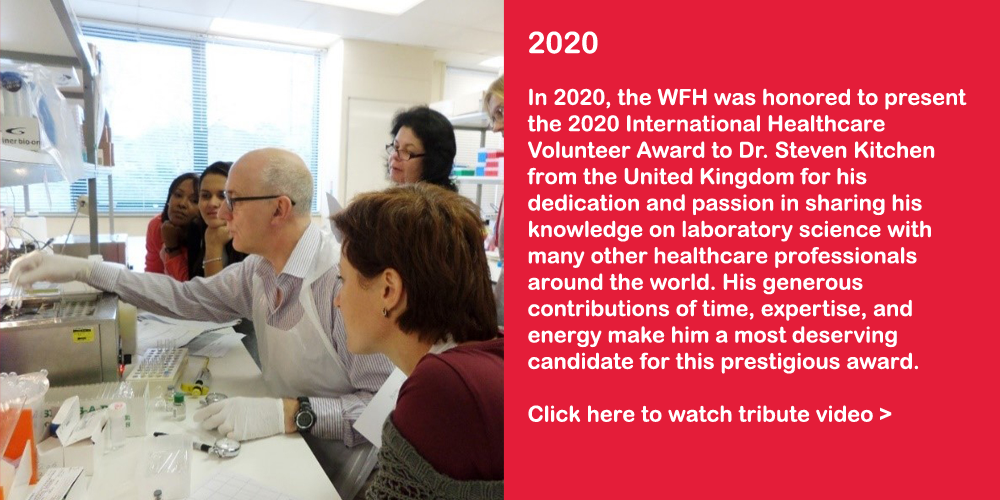The following joint statement is issued by the World Federation of Hemophilia (WFH), the European Haemophilia Consortium (EHC), and the National Hemophilia Foundation (NHF).
With the marketing authorization of the first AAV vector-based gene therapy products for hemophilia A and B, patients, their caregivers, and healthcare professionals have many considerations in assessing the benefits and risks in the context of shared decision-making frameworks.1,2,3,4 One of the most important elements in the decision-making process is a person’s AAV antibody status. While both valoctocogene roxaparvovec (Roctavian, AAV5-Factor VIII) and etranacogene dezaparvovec (Hemgenix, AAV5-Factor IX) use the AAV5 vector capsid for transgene delivery and integration, 5,6 a notable difference between their implementation in clinical practice is the availability of a companion diagnostic (CDx) AAV5 antibody assay for the former to help inform benefit-risk discussions with patients.
AAV antibodies naturally occur in many individuals due to prior exposure to one or more AAVs present in nature. While AAV does not cause any known disease in humans, an antibody immune response develops upon exposure to the AAV virus. While the gene therapy AAV vector does not contain any of the viral genes present in natural AAVs, the capsid coating of the vector is unchanged, and individuals may have antibodies that can neutralize and prevent the AAV gene therapy from working. Thus, screening for antibodies to AAV was conducted for many AAV-based gene therapy clinical trials, and participants with AAV antibodies have been excluded from most AAV therapeutic programs.
For patients considering valoctocogene roxaparvovec, an AAV5 total antibody CDx assay has been CE marked and approved for use with valoctocogene roxaparvovec in Europe. This is required as part of the European Medicines Agency (EMA) license before treatment.7 A premarket approval application (PMA) has been filed for the same assay with the U.S. Food and Drug Administration (FDA). The WFH, EHC, and NHF urge the respective health authorities to ensure a similar level of assessment for valoctocogene roxaparvovec as this product completes its review and approval assessment in the United States.
In the etranacogene dezaparvovec clinical trials, patients were enrolled with or without neutralizing antibodies to AAV5. The study results showed that patients with a positive anti-AAV5 antibody titer (<1:678) responded well to the gene therapy, with mean factor IX activity levels in the same range but numerically lower compared to those without neutralizing anti-AAV5 antibodies.8 One patient with a high titer to AAV5 (1:3212) had no response. Based upon the Phase 3 study, the FDA and EMA have requested further evaluation of neutralizing antibodies in hemophilia B patients, particularly high-titer patients. In the meantime, data from the Phase 3 study suggest titers above 1:700 should be the upper limit for hemophilia B patients wishing to take etranacogene dezaparvovec therapy until further data become available to indicate the efficacy in patients with titers above this threshold. For etranacogene dezaparvovec, we support the utilization of the available assay used in clinical trials, to facilitate an informed discussion between patients and physicians regarding the benefits and risks of treatment until such time as a validated assay is available.
The WFH, EHC, and NHF believe that assessment of a hemophilia patient’s antibody titer to AAV5 should be required before initiation of treatment. Efforts should aim to minimize the risk of non-response or suboptimal therapeutic response, or compromising a patient’s future opportunities for an AAV-based gene therapy. Based on geography, the regulatory requirements and expectations differ concerning how these assays may be available to patients.
Going forward, we request that all gene therapy developers and regulators ensure an appropriate assay to assess antibody titers for AAV-based gene therapies is available contemporaneous with market authorization.
To read the joint statement, as a PDF please click here.
1 First gene therapy to treat severe haemophilia A. European Medicines Agency. News release, June 24, 2022. www.ema.europa.eu/en/news/first-gene-therapy-treat-severe-haemophilia
2 First gene therapy to treat severe haemophilia B. European Medicines Agency. News release, December 16, 2022. www.ema.europa.eu/en/news/first-gene-therapy-treat-haemophilia-b
3 FDA Approves First Gene Therapy to Treat Adults with Hemophilia B. U.S. Food and Drug Administration. News release, November 22, 2022. www.fda.gov/news-events/press-announcements/fda-approves-first-gene-therapy-treat-adults-hemophilia-b
4 Wang M, Negrier C, Driessler F, Goodman C, Skinner MW. The Hemophilia Gene Therapy Patient Journey: Questions and Answers for Shared Decision-Making. Patient Preference and Adherence. 2022;16:1439-1447. https://doi.org/10.2147/PPA.S355627
5 Mahlangu J, Kaczmarek R, von Drygalski A, et al. Two-Year Outcomes of Valoctocogene Roxaparvovec Therapy for Hemophilia A. New England Journal of Medicine. 2023;388(8):694-705. https://doi.org/10.1056/NEJMoa2211075
6 Pipe SW, Leebeek FWG, Recht M, et al. Gene Therapy with Etranacogene Dezaparvovec for Hemophilia B. New England Journal of Medicine. 2023;388(8):706-718. https://doi.org/10.1056/NEJMoa2211644
7European Medicines Agency. Roctavian European public assessment report. Accessed March 7, 2023. www.ema.europa.eu/en/medicines/human/EPAR/roctavian-0
8 European Medicines Agency. Hemgenix European public assessment report. Accessed March 7, 2023. www.ema.europa.eu/en/medicines/human/EPAR/hemgenix












